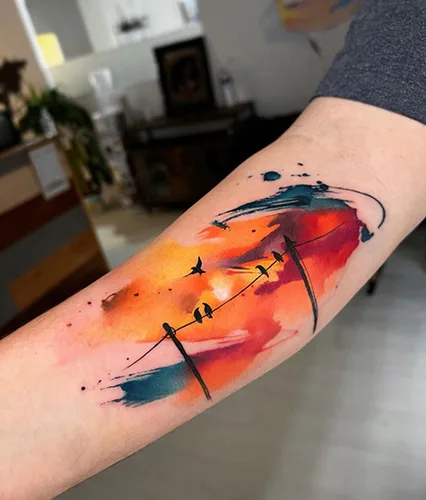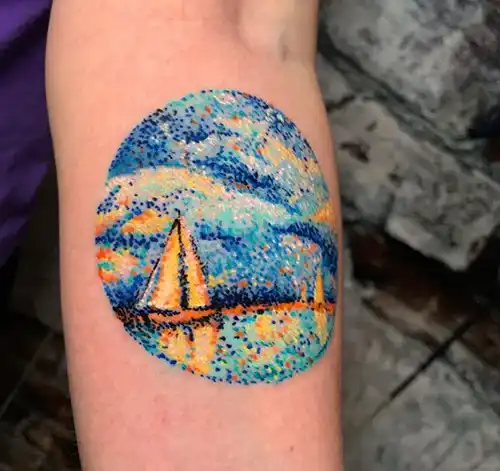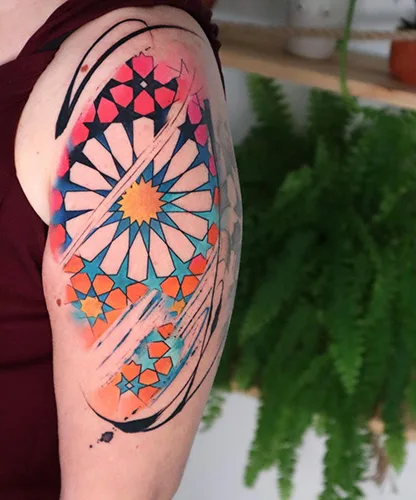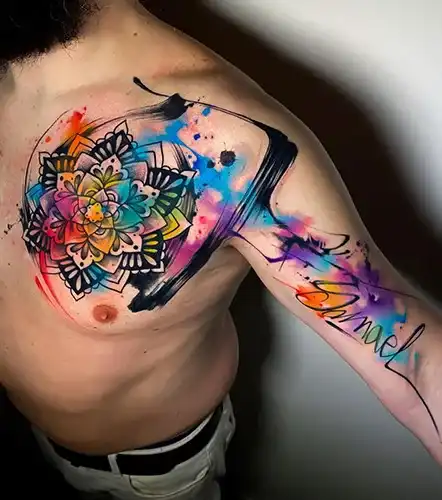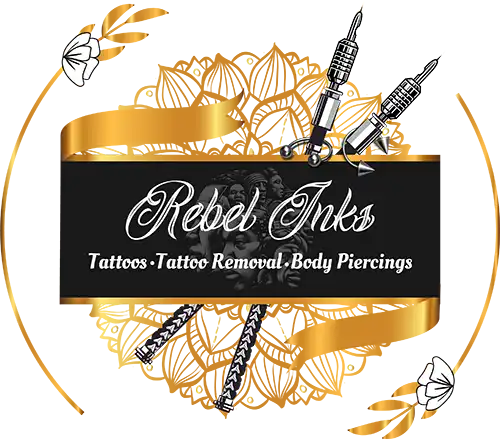Watercolor Tattoos in Nairobi, Kenya
When you think of tattoos, you tend to think about strong, dark outlines and expert shading; however, one design style that’s risen significantly in popularity within the last few years is watercolor tattoos.
Watercolor tattoos are a popular style of tattooing that mimics the look of watercolor paintings. Unlike traditional tattoos that use solid lines and blocks of color, watercolor tattoos typically feature soft, blended colors and brushstroke-like techniques, resembling the effect of watercolor paint on paper.
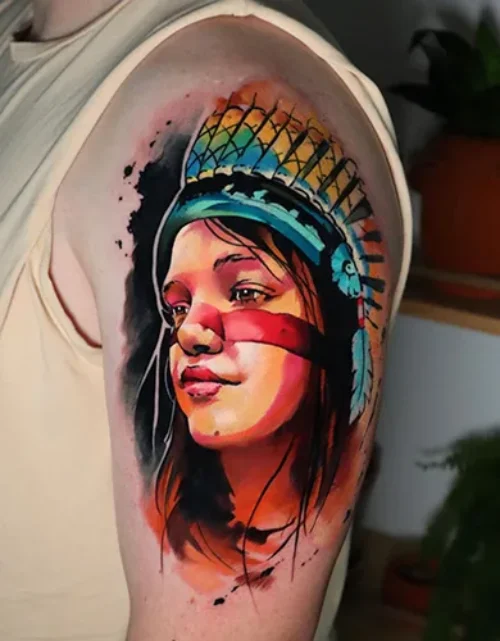
Watercolor Tattoos
It’s easy to assume that watercolor tattoos are made using different tools because their style is more delicate and fluid than “traditional” tattoos. However, watercolor tattoos are usually made using the same technique and don’t need a special setup. Finding an experienced and skilled artist is crucial since there is just one distinction between the two: a watercolor look can only be achieved by learning a variety of methods, such as blurs, bleeds, fades, and runs.
Here are some key characteristics and considerations when it comes to watercolor tattoos:
- Aesthetic Appeal: Watercolor tattoos are known for their vibrant and abstract appearance. They often incorporate a wide range of colors, including pastels and gradients, creating a more artistic and painterly effect on the skin.
Technique: Watercolor tattoos require a skilled artist who is proficient in blending colors and creating smooth transitions. The technique involves using various dilutions of tattoo ink and applying it in a freehand manner to achieve the desired watercolor effect. - Design Options: Watercolor tattoos can be versatile and adaptable to different design styles. They can incorporate elements such as flowers, animals, landscapes, abstract shapes, or even portraits, depending on the client’s preferences and the artist’s expertise.
- Fading and Aging: It’s important to note that watercolor tattoos may fade faster than traditional tattoos due to their softer and more delicate nature. The colors may also blend or blur over time, which can be both a positive or negative aspect depending on personal preference.
- Artist Selection: Given the intricate nature of watercolor tattoos, it’s crucial to choose an experienced tattoo artist who specializes in this style. Look for artists with a portfolio showcasing well-executed watercolor tattoos and positive client reviews.
- Skin Tone Considerations: Watercolor tattoos can look different on various skin tones. The natural pigmentation of the skin can affect how the colors appear, so it’s important to discuss your desired design with your chosen artist to ensure the best possible outcome.
- Aftercare: Proper aftercare is essential to maintain the longevity and vibrancy of your watercolor tattoo. Follow the artist’s instructions regarding cleaning, moisturizing, and avoiding prolonged sun exposure during the healing process.
As with any tattoo style, it’s crucial to research and find a reputable tattoo artist who can bring your watercolor tattoo vision to life. Remember to communicate your ideas clearly and ask for their input to create a design that suits your individual preferences and works well with the watercolor style.
Watercolor Tattoos Consultation and Design
When it comes to the consultation and design process for your watercolor tattoo, here are some considerations to keep in mind:
- Research and Prepare: Before your consultation, take the time to research watercolor tattoos and gather visual references that inspire you. Look for images, paintings, or even other watercolor tattoos that capture the style or elements you want to incorporate into your design. This will help you communicate your ideas effectively to the artist.
- Find a Specialized Artist: Look for a tattoo artist who specializes in watercolor tattoos and has a portfolio that showcases their expertise in this style. Browse through their previous work to ensure their artistic style aligns with your vision. It’s crucial to choose an artist who has experience and a strong understanding of how to create vibrant and well-blended watercolor effects. At Rebel Inks Tattoo Removal, Tattoos, and Piercings Parlour we offer the best professional services in Nairobi, Kenya, Contact Us today to schedule a consultation.
- Consultation Meeting: Schedule a consultation appointment with your chosen artist to discuss your tattoo ideas and design. During the meeting, be prepared to provide the artist with your visual references and explain your desired elements, such as subject matter, colors, and overall style. This is also an opportunity for the artist to evaluate your skin and discuss placement options.
- Artist’s Input: Listen to your artist’s input and advice. They have expertise in translating ideas into a tattoo that works well with the watercolor style. They can provide insights into color choices, composition, and adjustments needed for the design to be successful. Collaboration between you and the artist is essential for creating a unique and visually appealing watercolor tattoo.
- Customization and Adaptation: Watercolor tattoos offer a lot of room for customization and adaptation. Discuss any specific elements or personal touches you’d like to incorporate into the design. The artist can provide suggestions on how to adapt your ideas to work best within the watercolor style, ensuring a harmonious and aesthetically pleasing result.
- Size and Placement: Consider the size and placement of your tattoo carefully. Different body parts have varying shapes, contours, and skin textures, which can impact the tattoo design and its longevity. Your artist can guide you on suitable placement options based on the intricacy of the design and the feasibility of achieving the desired watercolor effects in specific areas.
- Sketch and Design Process: After discussing your ideas, the artist will typically create a sketch or outline of the design for your approval. This sketch allows you to visualize the placement and composition of the tattoo. Don’t hesitate to provide feedback and request adjustments if needed. The artist’s goal is to ensure you’re satisfied with the design before the actual tattooing process begins.
Remember, the consultation and design phase is an opportunity to collaborate with your artist and ensure that your vision for the watercolor tattoo is accurately captured. Open communication, mutual understanding, and a willingness to consider the artist’s expertise will help create a unique and stunning watercolor tattoo.
Watercolor Tattoos Design Styles
Watercolor tattoos can be adapted to various design styles, allowing for a wide range of creative possibilities. Here are some popular design styles that can be beautifully executed using watercolor techniques:
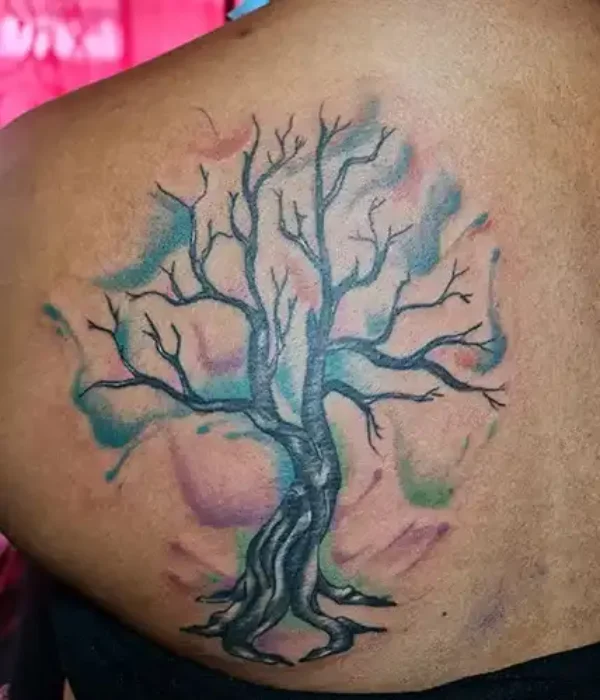
Floral and Botanical
Watercolor lends itself well to creating soft and ethereal floral and botanical designs. Delicate flowers, leaves, vines, and other natural elements can be rendered with gentle gradients and blending of colors, giving the tattoo a dreamy and organic look.
Nature and Landscapes
Watercolor tattoos can capture the essence of landscapes and nature scenes. From serene mountainscapes to vibrant sunsets or tranquil seascapes, the soft and flowing nature of watercolor techniques can create a sense of depth and movement, evoking a sense of awe and tranquility.
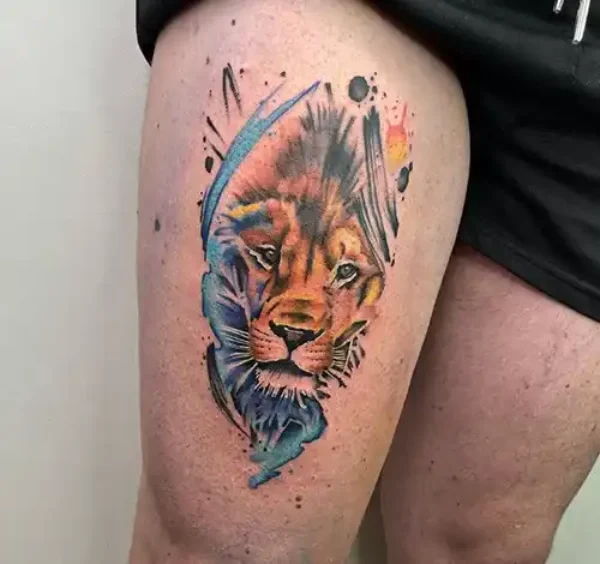


Animals and Wildlife
Watercolor tattoos can bring animals and wildlife to life with their expressive and fluid style. Whether it’s a majestic wolf, a graceful bird, or a colorful butterfly, the soft and blended colors can create a sense of whimsy and capture the natural beauty of the subject.
Abstract and Geometric
Watercolor tattoos can also be adapted to abstract or geometric designs. Blending colors and using subtle gradients can create abstract shapes and patterns, resulting in a unique and visually striking tattoo. Geometric elements, such as triangles, mandalas, or sacred geometry, can be enhanced with watercolor techniques to add depth and dimension.
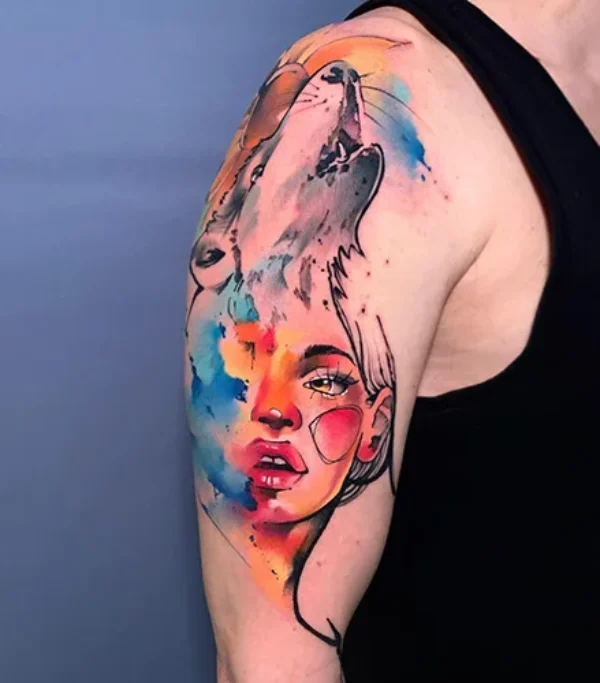


Portraits and Figures
While watercolor tattoos are known for their soft and blended look, they can also be used to create stunning portraits and figurative designs. By carefully layering and blending colors, an artist can capture the essence and emotion of a person’s face or body, resulting in a more painterly representation.
Surreal and Fantasy
Watercolor techniques can lend themselves well to surreal and fantasy-themed designs. The soft colors and dreamlike blending can enhance the otherworldly and imaginative aspects of the tattoo. From mythical creatures like unicorns or mermaids to whimsical dreamscapes, watercolor can bring these fantastical elements to life.
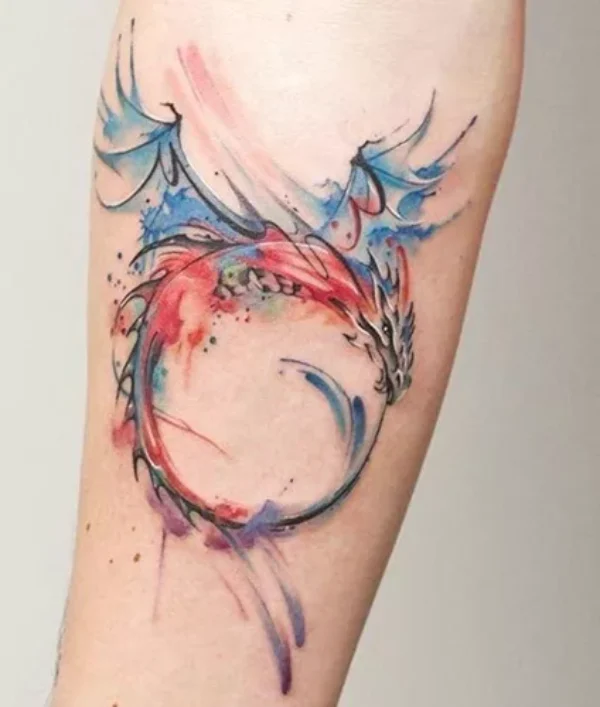


Remember, these design styles are just a starting point, and there are countless possibilities for creating unique watercolor tattoos. Work closely with your tattoo artist, share your ideas, and collaborate on developing a design that suits your vision and showcases the beauty of the watercolor style.
Schedule Appointment
Watercolor Tattoos Realistic Expectations
Having realistic expectations is crucial when getting a watercolor tattoo. Here are some points to consider:
- Fading and Blurring: Watercolor tattoos are known for their soft, blended colors. However, these colors may fade faster compared to traditional tattoos. The pigments used in watercolor tattoos tend to be more diluted, making them more susceptible to fading over time. Additionally, the colors may blend or blur slightly as the tattoo ages. Discuss these possibilities with your tattoo artist to have a clear understanding of how the tattoo may change over the years.
- Individual Skin Factors: Each person’s skin reacts differently to tattoos. Factors such as skin type, color, texture, and overall skin health can impact how the watercolor tattoo appears and ages. Skin that is prone to sun damage or doesn’t retain ink well may affect the longevity and vibrancy of the colors. Your tattoo artist can provide insights on how your specific skin characteristics may influence the tattoo’s outcome.
- Variability in Results: Watercolor tattoos are highly artistic and unique creations. The outcome can vary depending on the skill and technique of the tattoo artist, as well as individual factors like skin type and healing process. While your artist will strive to replicate your desired design, there may be slight variations in color intensity, blending, or other artistic elements.
- Touch-Ups and Maintenance: Due to the potential for color fading or blurring, you may need touch-up sessions to maintain the vibrancy of your watercolor tattoo over time. Discuss with your tattoo artist their policy on touch-ups and any associated costs. Additionally, proper aftercare and ongoing maintenance, such as using sunscreen and moisturizing the tattooed area, can help prolong the life of your watercolor tattoo.
- Subjective Appreciation: Watercolor tattoos are highly subjective, and individual preferences play a significant role in how they are perceived. It’s essential to consider your personal taste and how you connect with the artistic style of watercolor tattoos. While they can be visually stunning, some people may prefer the longevity and crispness of traditional tattoos.
By understanding these realistic expectations, you can make an informed decision about getting a watercolor tattoo. Communicate openly with your tattoo artist about your concerns and desired outcome. They can provide guidance based on their experience and help manage your expectations throughout the process.
Watercolor Tattoos Placement Considerations
When deciding on the placement of your watercolor tattoo, there are several considerations to keep in mind. Here are some placement considerations for watercolor tattoos:
- Skin Texture: Consider the texture of the skin in the desired placement area. Watercolor tattoos tend to have softer edges and blended colors, which may not show as well on rough or heavily textured skin. Areas with smoother skin, such as the upper arm, thigh, or back, may be more suitable for achieving the desired watercolor effect.
- Size and Detail: The size and level of detail in your watercolor tattoo design can impact the placement options. Intricate designs with small details may not translate well to areas with limited space, such as fingers or toes. Conversely, larger areas like the back or thigh provide more canvas for intricate watercolor designs.
- Visibility and Personal Preference: Consider whether you want your watercolor tattoo to be highly visible or more discreet. Some people prefer to showcase their tattoos, while others may prefer a more private placement. Placement on areas such as the forearm, upper arm, or calf can make the tattoo more visible, while areas like the ribcage, back, or upper thigh can be easily covered if desired.
- Movement and Friction: Keep in mind that certain body parts experience more movement and friction, which can impact the longevity and appearance of your tattoo. Areas prone to rubbing against clothing, such as the inner wrist or under the bra strap, may cause the tattoo to fade or blur more quickly. Consider how the placement will affect the tattoo’s exposure to potential friction.
- Pain and Sensitivity: Different areas of the body have varying levels of sensitivity and pain tolerance. Bony areas, such as the ribs, collarbone, or ankle, tend to be more sensitive and may cause more discomfort during the tattooing process. If pain is a concern for you, consider opting for a placement area that is generally less sensitive, such as the upper arm or thigh.
- Symmetry and Flow: Watercolor tattoos can often flow and blend well with the natural curves and contours of the body. Consider how the placement will affect the overall symmetry and flow of the design. Discuss with your tattoo artist how the design can be adapted to fit the chosen placement and enhance its visual appeal.
Remember, these considerations are general guidelines, and ultimately, the placement of your watercolor tattoo should be a personal decision. Consult with your tattoo artist, who can provide insights based on their experience and help you choose a placement option that best suits your design, preferences, and body anatomy.
Watercolor Tattoos Aftercare and Maintenance
Proper aftercare and maintenance are crucial for ensuring the healing and long-term vibrancy of your watercolor tattoo. Here are some guidelines to follow:
- Follow the Artist’s Instructions: Listen carefully to your tattoo artist’s aftercare instructions and follow them diligently. They may provide you with specific guidelines tailored to your tattoo and skin type. These instructions usually include how to clean, moisturize, and protect your tattoo during the initial healing period.
- Cleaning the Tattoo: Gently wash your tattooed area with lukewarm water and a mild, fragrance-free soap. Use your clean hands or a soft, non-abrasive cloth to cleanse the tattoo, avoiding excessive scrubbing. Pat the area dry with a clean towel or allow it to air dry.
- Moisturizing: After cleaning, apply a thin layer of fragrance-free and alcohol-free moisturizer to the tattooed area. Moisturizers that contain ingredients like shea butter or cocoa butter can be beneficial for keeping the skin hydrated. Apply the moisturizer regularly, following your artist’s recommendations.
- Avoid Picking or Scratching: Resist the urge to pick, scratch, or peel any scabs or flakes that may form on the tattooed area during the healing process. Doing so can disrupt the healing process, remove ink, and potentially cause infection.
- Sun Protection: Protect your watercolor tattoo from prolonged exposure to the sun, as ultraviolet (UV) rays can fade the colors over time. Once your tattoo is healed, apply a broad-spectrum sunscreen with a high SPF to the tattooed area when exposed to the sun. Reapply sunscreen as needed, especially if you’re swimming or sweating.
- Avoid Submerging in Water: While your tattoo is healing, avoid submerging it in bodies of water such as pools, hot tubs, and natural bodies of water. Excessive moisture can slow down the healing process and increase the risk of infection. Once your tattoo is fully healed, it’s generally safe to swim and bathe as usual.
Regular Moisturizing and Care: Even after your tattoo is fully healed, continue to moisturize the tattooed area regularly to keep the skin hydrated and maintain the vibrancy of the colors. Additionally, avoid exposing your tattoo to abrasive materials, excessive friction, or harsh chemicals. - Schedule Touch-Ups: Over time, the colors of your watercolor tattoo may naturally fade or lose some vibrancy. If desired, consult with your tattoo artist about scheduling touch-up sessions to refresh and enhance the colors of your tattoo. The frequency of touch-ups will depend on various factors, including the quality of the initial tattoo and how well you care for it.
Cost of Watercolor Tattoos in Nairobi, Kenya
The cost of watercolor tattoos can vary widely based on several factors, including the artist’s expertise, the size and complexity of the design, and the location of the tattoo studio. Here’s a detailed breakdown:
Factors Influencing Cost
- Artist’s Skill and Reputation:
– Experienced Artists: Artists specializing in watercolor tattoos, especially those with a strong portfolio, often charge higher rates due to the skill required to blend colors effectively. At Rebel Inks Tattoos, Tattoo Removal, and Body Piercings Parlour we have experienced artists who offer quality and premium services.
– Emerging Artists: Less experienced artists might offer lower rates, but it’s crucial to review their portfolio to ensure they can achieve the desired effect. - Tattoo Size and Complexity:
– Small Tattoos: Simple, small watercolor tattoos might be less expensive but still require precision and skill.
– Large Tattoos: Extensive designs covering larger areas will cost more due to the time and detail involved in blending colors and creating the desired effect. - Design Intricacy:
– Simple Designs: Basic watercolor patterns with fewer colors and details are generally quicker and cheaper.
– Intricate Designs: Highly detailed and complex watercolor tattoos take more time and skill, increasing the cost. - Location:
– Geographical Influence: Tattoo prices can vary significantly based on the local cost of living and the tattoo culture in different areas.
– Shop Location: High-end studios in prime locations may charge more. Rebel Inks Tattoos, Tattoo Removal, and Body Piercings Parlour is located in the heart of the Central Business Disrict (CBD) in Nairobi, Kenya, and is easily accessible to both locals and foreigners in the country - Time Investment:
– Session Requirements: Larger or more detailed watercolor tattoos may require multiple sessions, each adding to the overall cost.
Estimated Costs
- Small Watercolor Tattoo: Ksh. 5,000 to Ksh. 7,000
Examples: Small, simple designs such as a splash of color or a small floral element. - Medium Watercolor Tattoo: Ksh. 10,000 to Ksh. 13,000
Examples: Medium-sized patterns on the forearm, calf, or shoulder, with more color blending and detail. - Large Watercolor Tattoo: Ksh. 50,000 and up
Examples: Full sleeves, back pieces, or chest designs, with extensive color work and intricate details.
Additional Costs
- Consultation Fees: Some of our artists charge for consultations, especially if custom design work is involved.
- Touch-Ups: Watercolor tattoos may require touch-ups over time to maintain their vibrancy. Initial touch-ups might be included, but additional ones could incur extra charges.
- Aftercare Products: Proper aftercare is essential for healing, and specific products recommended by our artist might add to the overall cost.
Tips for Getting a Watercolor Tattoo
- Choose the Right Artist: Look for artists who specialize in watercolor tattoos and have a strong portfolio showcasing their ability to blend colors and create fluid designs. At Rebel Inks Tattoos, Tattoo Removal, and Body Piercings Parlour we have experienced artists who offer quality and premium services, Contact Us to get in touch with one of our expert artists.
- Consultation: Discuss your ideas with our artist to ensure they understand your vision and can execute it properly. Custom designs might take more time and thus cost more.
- Consider Placement: Think about how the placement of the tattoo will affect its appearance and longevity. Areas that experience more friction may cause the tattoo to fade faster.
- Aftercare: Follow our artist’s aftercare instructions meticulously to ensure your tattoo heals properly and maintains its quality. Proper care can prevent infections and fading, preserving the tattoo’s vibrancy.
- Understand Maintenance: Be aware that watercolor tattoos may fade more quickly than traditional tattoos and might require touch-ups to keep them looking fresh.
Watercolor tattoos are a beautiful and unique form of body art that can range from Ksh. 5,000 to several thousand dollars, depending on the artist’s expertise, the size and complexity of the design, and the location. By choosing a skilled artist and following proper aftercare, you can ensure that your watercolor tattoo remains a stunning and vibrant piece of art.
Get In Touch
For more information on the list above and any other special services,please call or come in for free consultation
Testimonials
The piercing wasn't as painful as I had thought and the process was quick and satisfactory. I love it!!!
The piercing is healing well thanks to the aftercare instructions and follow-up. I would highly recommend Rebel Inks
Eric also did a belly button piercing for a friend, guiding her through the process, doing the piercing and then explaining the after care to her.
The shop is on the 3rd floor, with the entrance to the stairs near an alleyway on the left. The shop is perfect size, clean, and attractive looking. The mural is pretty dope.
Thank you for the amazing service! 🔥👅✨
I got piercibgs there and the process was really good. My biggest concern was hygiene but that wasn't an issue at all, they use new needles and they sanitize them.
The service itself was also welcoming.
I was informes of everything i needed to know beforehand.
10/10 would recommend!
Eric was so calm and patient with my almost 2 year old lady. It was such a clean and hygienic process. We will definitely be back for our second rounds of piercings and maybe even another tattoo!
They assess the area before any art and advise one accordingly. They also give one post clean up process and also do a check up after the body art projects. Overall, I loved my experience and I’m hooked. 👍
Will definitely come back next time I’m in town 🙂
He listened to what I actually wanted and made sure he could fit in the time before I flew back home.
The shop is clean & private and is easy enough to find.
Eric has even checked in a couple of times since to make sure all is good.
I would totally recommend Eric! I absolutely love my Elephants!
I had a very easy healing period and always follow up from Eric to check on my progress...I would highly recommend if you are a first timer because from my experience all went very well and attention to detail
Thank you for a good job and looking forward to send all my friends your way
And all the best with the new year 2025!
From the moment I walked in, the staff was super friendly and made me feel at ease. The studio had a clean, professional atmosphere, which immediately put me at ease. My piercer was incredibly skilled and explained every step of the process, ensuring I was comfortable the entire time. The piercing was quick and practically painless, and the aftercare instructions were clear and easy to follow. I can tell they really care about the health and safety of their clients.
Overall, a fantastic experience—I highly recommend Rebel Inks and Tattoos for anyone looking to get pierced or tattooed!
They do follow up after their services
Eric's Studio isn’t just a place to get a tattoo—it’s an experience. The combination of professionalism, artistic talent, and a welcoming environment makes it a standout destination for anyone considering a tattoo.
I highly recommend Eric’s Studio to both first-timers and seasoned tattoo enthusiasts. If you’re looking for a high-quality tattoo and an enjoyable experience, this is the place to go.
I would definitely recommend their services again and again
Thank you Rebel Ink
My piercings are healing ❤️🩹 well
I would 💯 recommend
I will definitely come back for more .
Two, all the equipments he used for the piercings were new and/or sterilised.
Three, the parlour itself was very clean and was up to par with the hygiene standards.
Four, Eric provided effective aftercare instructions, making sure I knew exactly how to take care of my new piercings and he kept in touch and continues to do so, to check on the healing progress.
I highly highly highly recommend this place!!!
Would definitely recommend them to friends and go back for other piercings
Not only was the piercing process smooth, but he also provided thorough aftercare instructions, making sure I knew exactly how to take care of my new piercings. What really impressed me was that he keeps in touch to check on how the healing is progressing – a sign of true care for his clients.
The shop maintains a high standard of hygiene, and the atmosphere is welcoming and comfortable, which really added to the positive experience. I highly recommend this place to anyone looking for a professional and caring experience. I’ll definitely be coming back for any future piercings!
My appreciation for the excellent customer service I received. The follow-ups were prompt, and I truly appreciated the gentleness and professionalism throughout. Thank you!"
"Looking for professional eyebrow microshading removal? Look no further!"
The customer care is top tier 👌🏾👌🏾.
Wonderful place to get tattoos and piercings. 💯💯
Eric goes ahead to follow up on his clients progress and gives good advice each time I reach out to him.
I would recommend Reble tattoos anytime.
Good job bro we really appreciate.
Ohh and the price is very fair.
The environment was clean , procedure was sterile and the jewelry used are of the best quality.
He followed up with me during the healing process, he educated me on what I needed to do for my aftercare.
Eric is confident, skilled , experienced and the best piercer. Highly recommend Rebel inks.✨
Definitely recommend!
Great experience.
Eric definitely know what he is doing .
I got exactly what I wanted 2 tiny tats on the same finger .
He was kind and patient throughout the session.
Healing process has been good .
Aftercare services were given and regular checkups on the healing process were done.
I would 💯recommend.
Eric gave me the best reception as it was my first time there,and made me trust him all the way. I appreciate good services.
There services are also affordable not to forget 😊.
He was also invested in the aftercare and would ensure I follow the do's and don'ts in taking care of the tattoo and ensuring proper healing and maximum ink retention.
Would highly recommend Rebel Inks Tattoos.
Rebel Inks Tattoo offer the best,affordable and quality tattoo removal services.If you have unwanted ink,choose Rebel Inks Tattoo,they're the best of the best and the professionalism is a top notch.They ensure you're free from unwanted ink with their Laser Tattoo Removal Technology...
I did a Laser Tattoo Removal with them and i can attest they're the best....
Kudos Eric...
I highly recommend.
It was a generally good experience with good hygiene during the piercing process and has been a smooth healing process.... 10/10
tips. Highly recommend 👍🏽
100% recommendable.
I was particularly impressed with Eric's attention to hygiene. He thoroughly cleaned the room before I entered, sanitized all of the equipment he would be using, and changed gloves between each ear. This level of cleanliness gave me great confidence in his professionalism.
Eric's commitment to customer service did not end on the day of the piercing. He followed up with me regularly throughout the healing process to ensure that I was following the aftercare instructions and that my earlobes were healing properly.
I highly recommend Rebel Inks to anyone in Nairobi who is considering getting a piercing. Eric is a highly skilled and experienced piercer who takes great pride in his work.
So I Check all the boxes below and more:
Customer Care: ✔️
Professionalism : ✔️
Cleanliness ✔️
Price: ✔️
After care service ✔️
Thanks and good job, Eric
The place is neat and clean and the equipments he used were also fine standards. Really appreciate his following up with me on the healing 🤗
I WOULD HIGHLY RECOMMEND THEIR SERVICES to everyone. Actually what you see on their website is EXACTLY what you will get. Keep up the good work Rebel inks Tattoos.
The infection is now gone. I would definitely recommend!
Can recommend this place totally and would go back there anytime!
Thanks!
OUR LOCATION
Areas We Serve
NAIROBI
KIAMBU
KAJIADO
MACHAKOS

